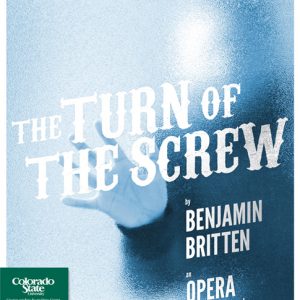
Deceit, betrayal, paranormal activity, and madness define the story behind Benjamin Britten’s opera The Turn of the Screw. Well known for its 12-note theme, The Turn of the Screw has proved to be a welcome challenge for Director Dr. Tiffany Blake and the students starring in the opera produced by the Charles and Reta Ralph Opera Center at Colorado State University.
“Given the musical complexity of the piece, it will help the students grow as musicians while the ambiguity of the opera will push their acting abilities,” said Blake.
Originally a novella written by Henry James, The Turn of the Screw is a story involving an unsuspecting Governess and the two children in her care, Miles and Flora. The Governess is hired under unusual circumstances; the father of the children demands that she does not contact him or question the history of the household. After a series of run-ins with ghosts, the father, and a peculiar housemaid, the audience is left questioning the Governess and the children.
“I want to give the audience the same experience I had in studying the story,” said Blake. “I’m presenting the piece as ambiguous as possible so that the audience can make their own assumptions.”
In the role of the Governess, graduate student Alexandra Diessner describes her character as naïve, sheltered, and quite possibly insane.
“The Governess is young, well-educated, and sheltered to the wickedness of the world. She enters the opera very innocent and ends very corrupted. She is naive but doesn’t believe she is,” said Diessner. “To be prepared for the Governess, I had to understand the story from beginning to end and understand what characters contribute to the change of governess.”
Blake, who has studied the novella and opera since she was introduced to the work in high school, defines the character of the Governess this way:
“The story of the Governess could be untrue because she isn’t a reliable witness, and she could be lying,” said Blake. “The way that Britten uses the motives between the characters is amazing.”
As the central character in the opera, graduate student Kimberli Render, who also performs as the Governess, has had to look deep inside the governess, while mastering the 12-tone opera.
“After reading several critical commentaries on the story and Henry James’s adaption, I’ve come to love the Governess; she’s very human and therefore complicated. We have been rehearsing since late November 2011, which may seem like a long time for one show, but with the caliber of musician and actor that Britten writes for, it is perfect,” says Render. “I doubt you will walk away humming one of the melodies, but you will definitely go on a musical journey through the crazy world of Britten.”
Diessner agrees that pinpointing the character’s development is just as important as perfecting the music.
“This is probably the most in-depth that I’ve ever analyzed a character in opera. Because the Governess is in 90 percent of the show, she has a much more sensitive and dramatic change as a character. Her development is huge from beginning to end. Every thought and new realization must be conveyed to the audience. So, with that being said, the subtext within the music is just as vital to convey as when the Governess is actually singing her thoughts,” said Diessner.
In addition to developing her character and the complicated music behind the opera, sophomore Ana Gray has studied the movements of a boy in order to play Miles.
“I have watched several different productions of the opera and taken notes on how to walk and act like a boy,” said Gray. “Another way I have prepared for this role is by reading and rereading the score for the show itself. I have played around with different background stories that I make up using the small amount of information given.”
As the students undergo the memorized run-throughs this month, the character development, paired with the music, is starting to come together.
“Every character is involved with another so closely, and Britten really brings that out by making many of the characters’ musical lines identical to each other,” said Gray.
As a personal project for Blake, the collaboration between the CSU Theatre division and the music program has been essential to making Blake’s vision a reality.
“The students and faculty involved see this project as mutually beneficial,” said Blake. “The technical theater students are exposed to a new work and are excited to create the illusions in the production. I’m very interested in learning from them, which has enhanced my own vision for the opera and helped me to achieve things I wouldn’t be able to in any other way.”
Gray summarizes the end result of the production as she explains Miles’ violent transitions in the story.
“I think the show makes the audience pay attention the entire time,” said Gray. “When I watched it for the first time, I was sucked in; I was dying because I wanted to know the end within the first 15 minutes of the show.”

